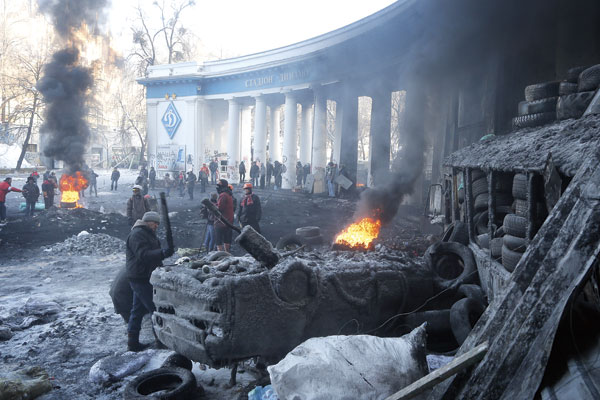Russia’s annexation of Crimea is set to have huge sporting repercussions, with Sevastopol and Tavriya Simferopol both likely to end their participation in the Ukrainian Premier League at the end of this season with the aim of joining the Russian Football Union.
The civil unrest which began in Kiev and led to the overthrow of the Ukrainian government began very close to the Dynamo Kiev stadium that bears the name of the club’s famous coach from years ago, Valeriy Lobanovskyi. His statue happened to be located directly between the demonstrators and the riot police during the protests, and it was heavily damaged when one group threw Molotov cocktails and the other responded with grenades. And the road leading to the Dynamo offices, close to the so-called “Government district”, was blocked by barricades built by protesters.
At the time, the Dynamo squad were at a training camp in Spain and on their return to Kiev they discovered that their Europa League tie against Valencia had been moved to Cyprus. Nearly 50,000 Dynamo supporters who had bought tickets for the game were forced to watch on TV as Oleh Blokhin’s side were beaten 2-0 in Limassol.
The return leg in Spain ended 0-0 and Dynamo exited the Europa League at the round-of-32 stage, along with fellow Ukrainian clubs Chornomorets, Dnipro and Shakhtar Donetsk – whose coach, Mircea Lucescu, said of his side’s 3-2 aggregate defeat by modest Viktoria Plzen: “The players are worried about their families and their future. They were not concentrating on football.”
More than a game
Football in the former Soviet Union was always more than just a game for the leaders of the respective republics who used it to further their own interests. In Ukraine, the achievements of Dynamo Kiev during the Soviet era were shared equally by coach Lobanovskyi and the head of Ukraine’s communists, Volodymyr Shcherbytsky – who sanctioned Lobanovskyi’s move from Dnipro to Dynamo in 1973.
“I was ordered by Shcherbytsky to invite Lobanovskyi from Dnipropetrovsk to give a presentation to the Politburo about Dynamo,” recalls Yakov Pogrebniyak, who was one of the highest-ranking members of Ukraine’s Communist Party and personally responsible for Dynamo. “He agreed but requested investment in the infrastructure and better payments for the players. The party members voted and Lobanovskyi received everything he wanted to build a strong side.”
Communists provided money, cars and flats for the Dynamo players, but they also made sure that they could control their assets by installing a direct phone line to Lobanovskyi’s office and even to the stadium dressing room.
Even after Ukraine gained independence in 1991, Dynamo remained the dominant domestic power, greatly supported by the offices of two Ukrainian presidents: Leonid Kravchuk and his successor, Leonid Kuchma.
Across the country, local billionaire oligarchs – each with close links to politicians – invested heavily in football clubs, with their profits bringing big foreign names to the country. Such spending helped Shakhtar to emerge as a rival power to Dynamo – thanks to support from the country’s now deposed president Victor Yanukovich – and they won the UEFA Cup in 2009.
But the newest generation of oligarchs has not been as fortunate as the likes of Ihor Surkis (Dynamo), Rinat Akhmetov (Shakhtar Donetsk), Ihor Kolomoyskyi (Dnipro) and Oleksandr Yaroslavsky (Metalist).
Serhiy Kurchenko, a 28-year-old billionaire who purchased Metalist from Yaroslavsky last year, escaped from the country after 11 criminal cases were opened against him. He had rocketed into the billionaire bracket in 2013 when his oil and gas companies floated. But as a close friend of the older son of dethroned president Yanukovich, he was accused of having received extremely favourable treatment during the acquisition of his business assets. Furthermore, it has been alleged that Kurchenko was nothing more than a front for the Yanukovich family’s business interests.
Kurchenko withdrew his funding for Metalist when the first clashes between protesters and the riot police began at the end of November last year, and the unstable financial situation led to the resignation of club coach Myron Markevych. To pay bills, Metalist sold top scorer Marko Devich to the Russian club Rubin Kazan for €7million, but that proved to be only a temporary solution.
Assets frozen
With all of Kurchenko’s assets frozen by the European Union, the future for Metalist looks bleak. Key players Jose Sosa and Jaja Coelho have left, while Argentinian striker Alejandro Gomez and Brazilian midfielder Diego Souza may not be far behind them. Sporting director Frank Arnesen has also gone.
Metalist are not the only club to have suffered from the mass exodus. Chornomorets, the revelation of the first half of the season, lost five foreigners: defenders Pablo Fontanello (Argentina) and Markus Berger (Austria), and midfielders Anderson Santana (Brazil), Franck Dja Djedje (France) and Sito Riera (Spain). Tavriya’s Sweden defender Gustav Svensson decided to return home due to the political instability in Crimea.
The Ukraine Premier League re-started in March following the postponement of two matchdays on security grounds, but some of the first games were characterised by drama and farce. Tavriya and Sevastopol, the two clubs from Crimea, faced serious problems when dealing with the peninsula’s new rulers, who tried to block their travel to league matches. Tavriya’s problems were exacerbated by the detention in Austria of their billionaire owner, Dmytro Firtash.
It was Dynamo president Surkis who stepped in to help Tavriya get to Kiev – paying for a charter flight from Turkey, where the squad had been training.
“I think that football can unite our nation,” said Surkis. “We all want to live in a friendly country. I’m sure football can provide the means to achieve that.”
However, the feeling remains that his sentiments are not in tune with the current realities of Ukrainian football.







